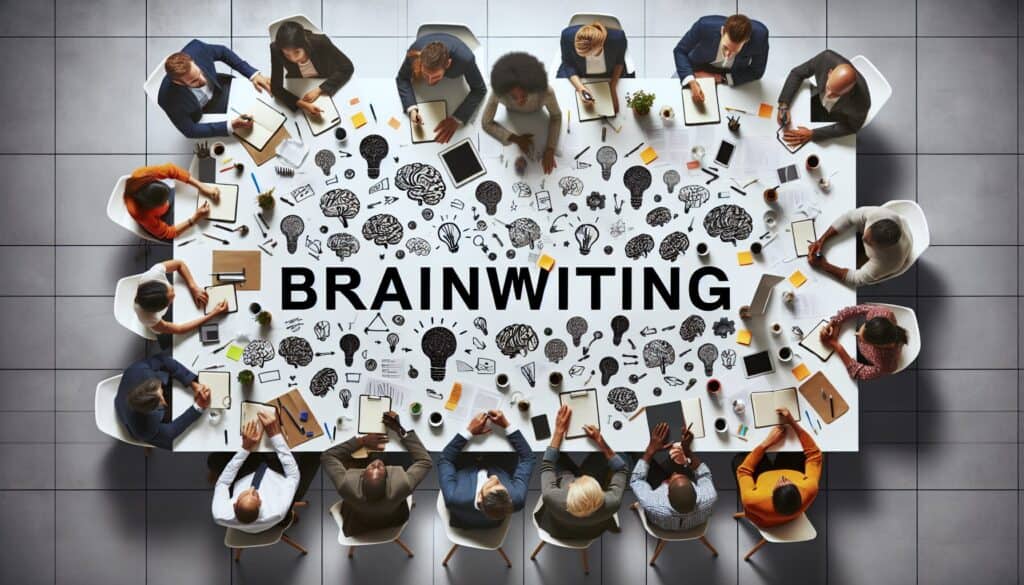An idea generation technique where participants write down their ideas individually before sharing them with the group, aiming to generate more ideas and reduce the influence of dominant personalities often found in verbal brainstorming.
- Méthodologies : Clients et marketing, Économie
Brainwriting

Brainwriting
- Méthodologie Agile, Remue-méninges, Créativité, Collaboration interfonctionnelle, Pensée conceptuelle, Idéation, Innovation, Travail d'équipe, User-Centered Design
Objectif :
Comment il est utilisé :
- Participants silently write down a set number of ideas related to a specific problem or topic on paper or cards. These ideas are then passed around the group, with others building upon or adding new ideas based on what they read. This continues for several rounds.
Avantages
- Encourages participation from all individuals, including introverts; Generates a large quantity of ideas quickly; Reduces evaluation apprehension and groupthink; Allows for parallel idea generation.
Inconvénients
- May lack the dynamic interaction and spontaneous energy of verbal brainstorming; Can sometimes lead to similar ideas if not well-facilitated; Requires clear instructions and time management.
Catégories :
- Idéation, Résolution de problèmes, Conception de Produits
Idéal pour :
- Generating a large number of diverse ideas in a structured way that encourages equal participation and minimizes social pressures.
Brainwriting proves advantageous across various project stages, particularly in the idea generation phase of product design and innovation processes. This method finds resonance in industries such as technology, consumer goods, and healthcare, where the need for diverse perspectives catalyzes groundbreaking solutions. It suits teams with mixed personalities, ensuring that introverted participants can share their contributions without the anxiety that often accompanies vocal brainstorming sessions. Typically initiated by a facilitator or team leader, this methodology encourages cross-functional collaboration, inviting input from individuals with varying expertise—from engineers to marketing professionals. Each participant’s anonymity in their initial contributions mitigates the risk of judgment, enabling unconventional ideas to emerge. The iterative nature of passing and building upon previous ideas can lead to unexpected synergies and innovations, making it particularly effective for teams tackling complex problems. The cyclical process, usually set within a structured timeframe, allows teams to revisit and refine ideas, often leading to the rapid development of concepts that might not have surfaced through traditional discussion formats. This can be especially useful during hackathons or innovation workshops, where time is limited, yet creativity must flourish. Through brainwriting, organizations can harness a wealth of ideas in a short span, thereby accelerating the momentum towards impactful product development initiatives.
Principales étapes de cette méthodologie
- Define the problem or topic clearly.
- Set a specific time limit for idea generation.
- Each participant writes down their ideas on paper or cards.
- After a set time, participants pass their papers or cards to the next person.
- Participants read the ideas they receive and build upon them or add new ideas.
- Repeat the passing and building process for several rounds.
- Conclude the session when time is up, ensuring all ideas have been shared.
Conseils de pro
- Incorporate diverse perspectives by grouping participants with varied backgrounds and experiences to spark unconventional ideas.
- Establish a clear theme or challenge statement to align contributions and ensure focused ideation throughout the process.
- Introduce timed rounds to maintain momentum and encourage quick thinking, thereby increasing the breadth of ideas generated.
Lire et comparer plusieurs méthodologies, nous recommandons le
> Référentiel méthodologique étendu <
ainsi que plus de 400 autres méthodologies.
Vos commentaires sur cette méthodologie ou des informations supplémentaires sont les bienvenus sur le site web de la Commission européenne. section des commentaires ci-dessous ↓ , ainsi que toute idée ou lien en rapport avec l'ingénierie.
Contexte historique
1949
1950
1950
1960
1960
1960
1960
1940
1950
1950
1958
1960
1960
1960
1960
(si la date est inconnue ou n'est pas pertinente, par exemple "mécanique des fluides", une estimation arrondie de son émergence notable est fournie)















Articles Similaires
Gestion des opérations de fabrication (MOM)
Système d'exécution de la fabrication (MES)
Plan de contrôle de la fabrication
Tests manuels
Tableaux d'évaluation des manutentions manuelles (MAC)
ManTRA (outil d'évaluation des risques liés aux tâches manuelles)